Energy Storage Science and Technology ›› 2020, Vol. 9 ›› Issue (5): 1454-1466.doi: 10.19799/j.cnki.2095-4239.2020.0126
• Energy Storage Materials and Devices • Previous Articles Next Articles
Yun LU1( ), Jianing LIANG1, Yong ZHU2, Zhengrong LI1, Yezhou HU1, Ke CHEN1, Deli WANG1(
), Jianing LIANG1, Yong ZHU2, Zhengrong LI1, Yezhou HU1, Ke CHEN1, Deli WANG1( )
)
Received:2020-03-31
Revised:2020-04-20
Online:2020-09-05
Published:2020-09-08
Contact:
Deli WANG
E-mail:yunlu-hbu@foxmail.com;wangdl81125@hust.edu.cn
CLC Number:
Yun LU, Jianing LIANG, Yong ZHU, Zhengrong LI, Yezhou HU, Ke CHEN, Deli WANG. Recent progress in organics derived cathode materials for lithium sulfur batteries[J]. Energy Storage Science and Technology, 2020, 9(5): 1454-1466.

Fig.2
The structure cognitive process of S@PAN: (a) the possible molecular structure of S@PAN according to Buchmeiser et al. in 2011; (b) the revised S@PAN structure based on C/H element ratio by Zhang et al. in 2014; (c) the possible molecular structure of S@PAN according to Archer et al. in 2015; (b) the demonstrated S@PAN structure based on the integration of 13C Solid State Nuclear Magnetic Resonance as well as quantum chemistry simulation by Ming et al. in 2018"


Fig.3
The cognitive process of S@PAN reaction mechanism: (a) the possible reaction mechanism of S@PAN according to Wang et al. in 2013; (b) the reaction mechanism of S@PAN based on SS-NMR and ex-situ XPS by Yang et al. in 2018; (c) the integration of 7Li solid state nuclear magnetic resonance as well as quantum chemistry simulation by Ming et al. in 2018"
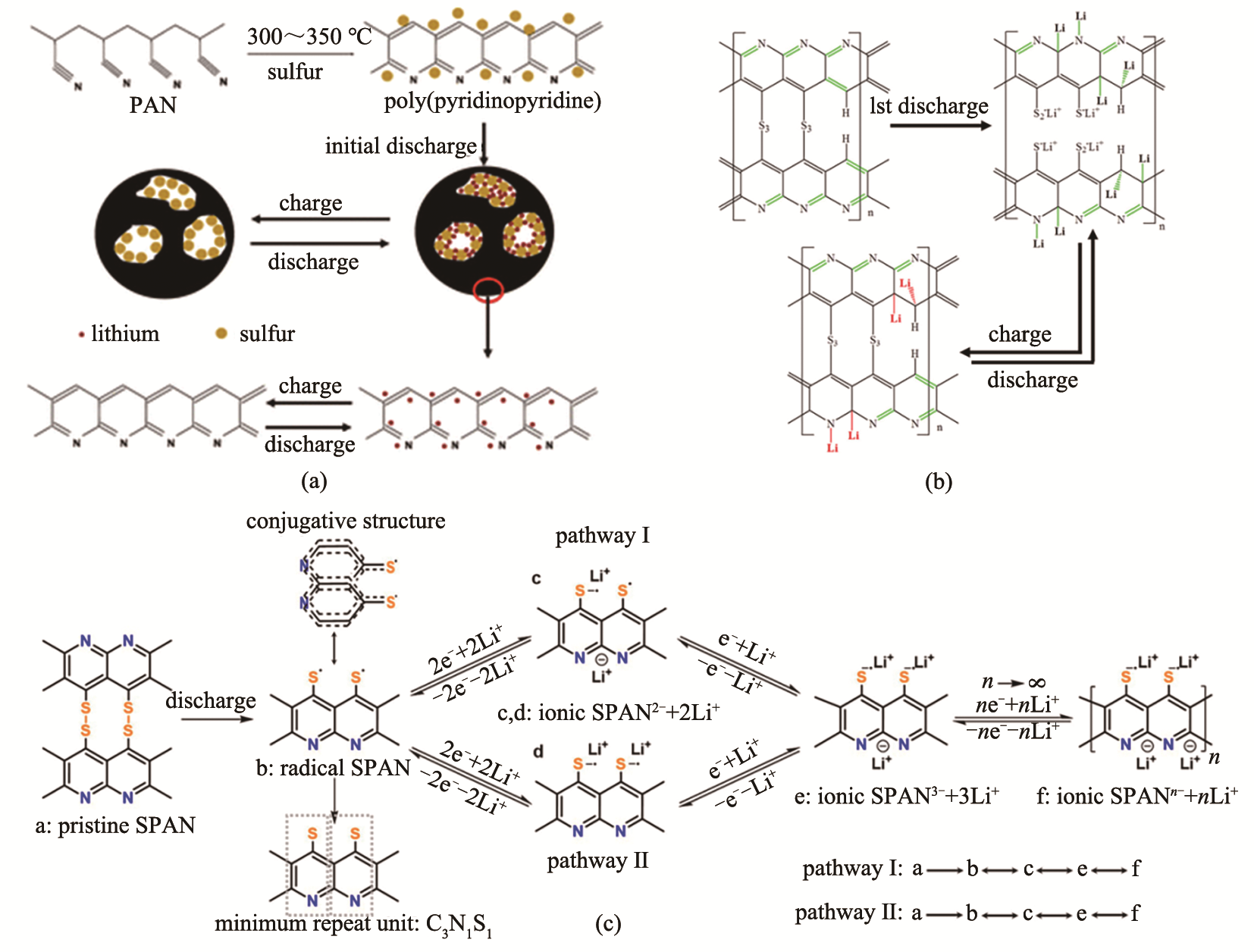
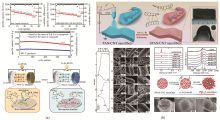
Fig.4
Design and construct the new S@PAN energy storage system: (a) the introduction of Se into S@PAN system to enhance the fast redox reaction, and further improve the reaction kinetics by Xie et al; (b) Liu et al. in 2019 introduce the CNTs to design 3D conductive network via electrostatic spinning, and further improve the reaction kinetics"


Fig.5
The preparation of unsaturated hydrocarbon derived organic sulfur electrode: (a) synthetic scheme for the first copolymerization of S8 with DIB to form chemically stable sulfur copolymers by Pyun et al. in 2013; (b) schematic illustration from DEB with S8 to form copolymer by Meng et al. in 2014; (c) schematic illustration from ProDOT-Sty with S8 to form copolymer to enhance both conductivity and sulfur loadings by Pyun et al. in 2015; (d) synthetic approach for the copolymerization P3HT with S8 and proposed microstructure of the copolymer-containing sample by Zentel et al. in 2015"
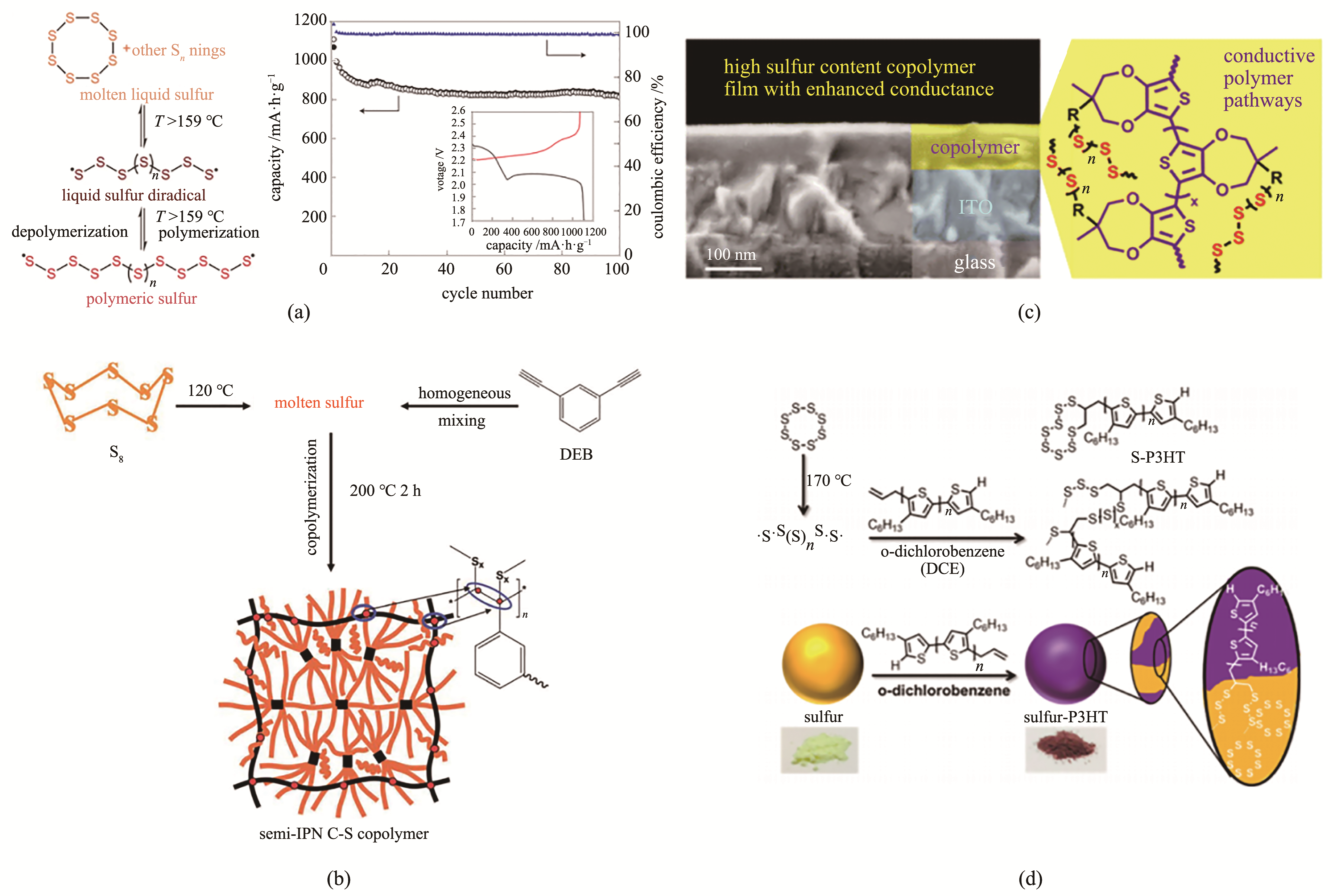
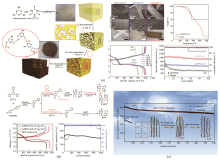
Fig.6
The preparation of thiol group derived organic sulfur electrode: (a) synthetic scheme for the first copolymerization of S8 with TTCA to form chemically stable sulfur copolymers via soft-templates by Park et al. in 2015; (b) schematic illustration to form sulfur rich S-BOP copolymer through one pot method by Choi et al. in 2016; (c) schematic illustration to immobilize sulfur on the adsorbed base via reverse vulcanization by Chen et al. in 2018"

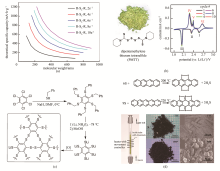
Fig.7
The preparation of micro-molecules organic sulfur electrode: (a) theoretical specific capacity of various micro-molecules of sulfur (b) PMTT as high performance Li-S cathode by Fu et al. in 2017; (c) a crosslinked polymer of one benzene ring unit with six sulfur atoms reported by Preefer et al. in 2017; (d) 2019, Long et al. synthesis of single crystal TTT and HTP via intermittent heating strategy"

| 1 | DUNN B, KAMATH H, TARASCON J M. Electrical energy storage for the grid: A battery of choices[J]. Science, 2011, 334(6058): 928-935. |
| 2 | CAO Y, LI M, LU J, et al. Bridging the academic and industrial metrics for next-generation practical batteries[J]. Nat. Nanotechnol., 2019, 14(3): 200-207. |
| 3 | LARCHER D, TARASCON J M. Towards greener and more sustainable batteries for electrical energy storage[J]. Nat. Chem., 2015, 7(1): 19-29. |
| 4 | SHANG C, CAO L, YANG M, et al. Freestanding Mo2C-decorating N-doped carbon nanofibers as 3D current collector for ultra-stable Li-S batteries[J]. Energy Storage Mater., 2019, 18: 375-381. |
| 5 | LU Y Q, WU Y J, SHENG T, et al. Novel sulfur host composed of cobalt and porous graphitic carbon derived from mofs for the high-performance Li-S battery[J]. ACS Appl. Mater. Interfaces, 2018, 10(16): 13499-13508. |
| 6 | LI G, LEI W, LUO D, et al. 3D porous carbon sheets with multidirectional ion pathways for fast and durable lithium-sulfur batteries[J]. Adv. Energy Mater., 2018, 8(8): doi: 10.1002/aenm.201702381. |
| 7 |
CHEN W J, LI B Q, ZHAO C X, et al. Electrolyte regulation towards stable lithium metal anode in lithium-sulfur batteries with sulfurized polyacrylonitrile cathode[J]. Angew. Chem, Int. Ed., doi: 10.1002/ange.201912701.
doi: 10.1002/ange.201912701 |
| 8 | LI X, BANIS M, LUSHINGTON A, et al. A high-energy sulfur cathode in carbonate electrolyte by eliminating polysulfides via solid-phase lithium-sulfur transformation[J]. Nat. Commun., 2018, 9(1): 4509-4519. |
| 9 | LI G, WANG X, SEO M H, et al. Chemisorption of polysulfides through redox reactions with organic molecules for lithium-sulfur batteries[J]. Nat. Commun., 2018, 9(1): 705-715. |
| 10 | YUAN H, ZHANG W, WANG J G, et al. Facilitation of sulfur evolution reaction by pyridinic nitrogen doped carbon nanoflakes for highly-stable lithium-sulfur batteries[J]. Energy Storage Mater., 2018, 10: 1-9. |
| 11 | 袁艳, 郑东东, 方钊, 等. 锂硫电池硫正极技术研究进展[J]. 储能科学与技术, 2018, 7(4): 618-630. |
| YUAN Y, ZHENG D, FANG Z, et al. The research progress of Li-S cathode technologies[J]. Energy Storage Science and Technology, 2018, 7(4): 618-630. | |
| 12 | ZHONG Y, XIA X, DENG S, et al. Popcorn inspired porous macrocellular carbon: Rapid puffing fabrication from rice and its applications in lithium-sulfur batteries[J]. Adv. Energy Mater., 2018, 8(1): doi:10.1002/aenm.201701110. |
| 13 | LIU D, ZHANG C, ZHOU G, et al. Catalytic effects in lithium-sulfur batteries: Promoted sulfur transformation and reduced shuttle effect[J]. Adv. Sci., 2018, 5(1): doi: 10.1002/advs.201700270. |
| 14 | LIU S, LI J, YAN X, et al. Superhierarchical cobalt-embedded nitrogen-doped porous carbon nanosheets as two-in-one hosts for high-performance lithium-sulfur batteries[J]. Adv. Mater., 2018, 30(12): doi: 10.1002/adma.201706895. |
| 15 | 闻雷, 梁骥, 石颖, 等. 柔性锂硫电池的材料设计与实现[J]. 储能科学与技术, 2018, 7(3): 465-470. |
| WEN L, LIANG J, SHI Y, et al. The design and achievemrnt of flexible lithium sulfur battery[J]. Energy Storage Science and Technology, 2018, 7(3): 465-470. | |
| 16 | YAMIN H, GORENSHTEIN A, PENCINER J, et al. Lithium sulfur battery oxidation/reduction mechanisms of polysulfides in THF solutions[J]. J. Electrochem. Soc., 1988, 135(5): 1045-1048. |
| 17 | KONG L, CHEN X, LI B Q, et al. A bifunctional perovskite promoter for polysulfide regulation toward stable lithium-sulfur batteries[J]. Adv. Mater., 2018, 30(2): doi: 10.1002/adma.201705219. |
| 18 | GUEON D, HWANG J T, YANG S B, et al. Spherical macroporous carbon nanotube particles with ultrahigh sulfur loading for lithium-sulfur battery cathodes[J]. ACS Nano, 2018, 12(1): 226-233. |
| 19 | PANG Q, SHYAMSUNDER A, NARAYANAN B, et al. Tuning the electrolyte network structure to invoke quasi-solid state sulfur conversion and suppress lithium dendrite formation in Li-S batteries[J]. Nat. Energy, 2018, 3(9): 783-791. |
| 20 | 胡策军, 杨积瑾, 王航超, 等. 锂硫电池安全性问题现状及未来发展态势[J]. 储能科学与技术, 2018, 7(6): 1082-1093. |
| HU C, YANG J, WANG H, et al. The safety of Li-S batteries in current situation and future development[J]. Energy Storage Science and Technology, 2018, 7(6): 1082-1093. | |
| 21 | 张辰, 刘东海, 吕伟, 等. 高体积能量密度锂硫电池的构建材料和电极[J]. 储能科学与技术, 2017, 6(3): 550-556. |
| ZHANG C, LIU D, LYU W, et al. The construction of high volume energy density lithium sulfur battery[J]. Energy Storage Science and Technology, 2017, 6(3): 550-556. | |
| 22 | LIU Y, WANG W, WANG A, et al. A polysulfide reduction accelerator—NiS2-modified sulfurized polyacrylonitrile as a high performance cathode material for lithium-sulfur batteries[J]. J. Mater. Chem. A, 2017, 5(42): 22120-22124. |
| 23 | LI G, LEI W, LUO D, et al. Stringed “tube on cube” nanohybrids as compact cathode matrix for high-loading and lean-electrolyte lithium-sulfur batteries[J]. Energy Environ. Sci., 2018, 11(9): 2372-2381. |
| 24 | 谷穗, 靳俊, 卢洋, 等. 锂硫电池的穿梭效应与抑制[J]. 储能科学与技术, 2017, 6(5): 1026-1040. |
| GU S, JIN J, LU Y, et al. The shuttle effects and inhibition method of lithium-sulfur battery[J]. Energy Storage Science and Technology, 2017, 6(5): 1026-1040. | |
| 25 | WANG L, MENAKATH A, HAN F, et al. Identifying the components of the solid-electrolyte interphase in Li-ion batteries[J]. Nature Chem., 2019, 11(9): 789-796. |
| 26 | WENG G M, YANG B, LIU C Y, et al. Asymmetric allyl-activation of organosulfides for high-energy reversible redox flow batteries[J]. Energy Environ. Sci., 2019, 12(7): 2244-2252. |
| 27 | TANG J, LIU J, LI C, et al. Synthesis of nitrogen-doped mesoporous carbon spheres with extra-large pores through assembly of diblock copolymer micelles[J]. Angew. Chem, Int. Ed., 2015, 54(2): 588-593. |
| 28 | HU L, DAI C, LIU H, et al. Double-shelled NiO-NiCo2O4 heterostructure@carbon hollow nanocages as an efficient sulfur host for advanced lithium-sulfur batteries[J]. Adv. Energy Mater., 2018, 8(23): doi: 10.1002/aenm.201800709. |
| 29 | WANG X, QIAN Y, WANG L, et al. Sulfurized polyacrylonitrile cathodes with high compatibility in both ether and carbonate electrolytes for ultrastable lithium-sulfur batteries[J]. Adv. Funct. Mater., 2019: doi: 10.1002/adfm.201902929. |
| 30 | HU P, HE X, NG M F, et al. Trisulfide-bond acenes for organic batteries[J]. Angew. Chem, Int. Ed., 2019, 58(38): 13513-13521. |
| 31 | 杨裕生,王维坤,苑克国,等. 锂电池正极材料有机多硫化物的展望[J]. 电池, 2002, S1: 1-5. |
| YANG Y, WANG W, YUAN K, et al. The prospect of organic polysulfide as anode material for lithium batteries[J]. Bimonthly Battery, 2002, S1: 1-5. | |
| 32 | WANG J, YANG J, XIE J, et al. A novel conductive polymer-sulfur composite cathode material for rechargeable lithium batteries[J]. Adv. Mater., 2002, 14(13/14): 963-965. |
| 33 | WANG J, YANG J, WAN C, et al. Sulfur composite cathode materials for rechargeable lithium batteries[J]. Adv. Funct. Mater., 2003, 13(6): 487-492. |
| 34 | FANOUS J, WEGNER M, GRIMMINGER J, et al. Structure-related electrochemistry of sulfur-poly(acrylonitrile) composite cathode materials for rechargeable lithium batteries[J]. Chem. Mater., 2011, 23(22): 5024-5028. |
| 35 | ZHANG S. Understanding of sulfurized polyacrylonitrile for superior performance lithium/sulfur battery[J]. Energies, 2014, 7(7): 4588-4600. |
| 36 | WEI S, MA L, HENDRICKSON K E, et al. Metal-sulfur battery cathodes based on pan-sulfur composites[J]. J. Am. Chem. Soc., 2015, 137(37): 12143-12152. |
| 37 | WANG W, CAO Z, ELIA G A, et al. Recognizing the mechanism of sulfurized polyacrylonitrile cathode materials for Li-S batteries and beyond in Al-S batteries[J]. ACS Energy Lett., 2018, 3(12): 2899-2907. |
| 38 | YU X G, XIE J Y, YANG J, et al. Lithium storage in conductive sulfur-containing polymers[J]. J. Electroanal. Chem., 2004, 573(1): 121-128. |
| 39 | JIN Z Q, LIU Y G, WANG W K, et al. A new insight into the lithium storage mechanism of sulfurized polyacrylonitrile with no soluble intermediates[J]. Energy Storage Mater., 2018, 14: 272-278. |
| 40 | WANG L, HE X, SUN W, et al. Organic polymer material with a multi-electron process redox reaction: Towards ultra-high reversible lithium storage capacity[J]. RSC Adv., 2013, 3(10): 3227-3231. |
| 41 | CHEN X, PENG L, WANG L, et al. Ether-compatible sulfurized polyacrylonitrile cathode with excellent performance enabled by fast kinetics via selenium doping[J]. Nat. Commun., 2019, 10(1): 1021-1030. |
| 42 | CHUNG W J, GRIEBEL J J, KIM E T, et al. The use of elemental sulfur as an alternative feedstock for polymeric materials[J]. Nat. Chem., 2013, 5(6): 518-524. |
| 43 | SUN Z, XIAO M, WANG S, et al. Sulfur-rich polymeric materials with semi-interpenetrating network structure as a novel lithium-sulfur cathode[J]. J. Mater. Chem. A, 2014, 2(24): 9280-9286. |
| 44 | DIRLAM P T, SIMMONDS A G, SHALLCROSS R C, et al. Improving the charge conductance of elemental sulfur via tandem inverse vulcanization and electropolymerization[J]. ACS Macro Lett., 2015, 4(1): 111-114. |
| 45 | OSCHMANN B, PARK J, KIM C, et al. Copolymerization of polythiophene and sulfur to improve the electrochemical performance in lithium-sulfur batteries[J]. Chem. Mater., 2015, 27(20): 7011-7017. |
| 46 | KIM H, LEE J, AHN H, et al. Synthesis of three-dimensionally interconnected sulfur-rich polymers for cathode materials of high-rate lithium-sulfur batteries[J]. Nat. Commun., 2015, 6: 7278-7288. |
| 47 | JE S H, HWANG T H, TALAPANENI S N, et al. Rational sulfur cathode design for lithium-sulfur batteries: Sulfur-embedded benzoxazine polymers[J]. ACS Energy Lett., 2016, 1(3): 566-572. |
| 48 | ZENG S, LI L, YU J, et al. Highly crosslinked organosulfur copolymer nanosheets with abundant mesopores as cathode materials for efficient lithium-sulfur batteries[J]. Electrochim. Acta, 2018, 263: 53-59. |
| 49 | VISCO S J, DEJONGHE L C. Ionic conductivity of organosulfur melts for advanced storage electrodes[J]. J. Electrochem. Soc., 1989, 135(12): 2905-2909. |
| 50 | LIU M, STEVEN J V, JONGHE L C D. Electrochemical properties of organic disulfide/thiolate redox couples[J]. J. Electrochem. Soc., 1989, 136(9): 2570-2575. |
| 51 | WU M, CUI Y, BHARGAV A, et al. Organotrisulfide: A high capacity cathode material for rechargeable lithium batteries[J]. Angew. Chem., Int. Ed., 2016, 55(34): 10027-10031. |
| 52 | WU M, BHARGAV A, CUI Y, et al. Highly reversible diphenyl trisulfide catholyte for rechargeable lithium batteries[J]. ACS Energy Lett., 2016, 1(6): 1221-1226. |
| 53 | WANG D Y, GUO W, FU Y. Organosulfides: An emerging class of cathode materials for rechargeable lithium batteries[J]. ACC. Chem. Res., 2019, 52(8): 2290-2300. |
| 54 | BHARGAV A, MA Y, SHASHIKALA K, et al. The unique chemistry of thiuram polysulfides enables energy dense lithium batteries[J]. J. Mater. Chem. A, 2017, 5(47): 25005-25013. |
| 55 | PREEFER M B, OSCHMANN B, HAWKER C J, et al. High sulfur content material with stable cycling in lithium-sulfur batteries[J]. Angew. Chem., Int. Ed., 2017, 129(47): 15314-15318. |
| 56 | WU T, JING M, YANG L, et al. Controllable chain-length for covalent sulfur-carbon materials enabling stable and high-capacity sodium storage[J]. Adv. Energy Mater., 2019, 9(9): doi: 10.1002/aenm.201803478. |
| 57 | WU T, JING M, TIAN Y, et al. Surface-driven energy storage behavior of dual-heteroatoms functionalized carbon material[J]. Adv. Funct. Mater., 2019, 29(17): doi: 10.1002/adfm.201900941. |
| [1] | Chang SUN, Zerong DENG, Ningbo JIANG, Lulu ZHANG, Hui FANG, Xuelin YANG. Recent research progress of sodium vanadium fluorophosphate as cathode material for sodium-ion batteries [J]. Energy Storage Science and Technology, 2022, 11(4): 1184-1200. |
| [2] | Qiang CHEN, Min LI, Jingfa LI. Application of Prussian blue analogs and their derivatives in potassium ion batteries [J]. Energy Storage Science and Technology, 2021, 10(3): 1002-1015. |
| [3] | Yongli HENG, Zhenyi GU, Jinzhi GUO, Xinglong WU. Na3V2(PO4)3@C cathode material for aqueous zinc-ion batteries [J]. Energy Storage Science and Technology, 2021, 10(3): 938-944. |
| [4] | Xinxin ZHU, Wei JIANG, Zhengwei WAN, Shu ZHAO, Zeheng LI, Liguang WANG, Wenbin NI, Min LING, Chengdu LIANG. Research progress in electrolyte and interfacial issues of solid lithium sulfur batteries [J]. Energy Storage Science and Technology, 2021, 10(3): 848-862. |
| [5] | Min'an YANG, Ning CHEN, Bo WANG, Qian ZHANG, Jingpei CHEN, Hailei ZHAO, Fushen LI. Gene law about cycle stability of cathode material for lithium-ion batteries [J]. Energy Storage Science and Technology, 2021, 10(2): 462-469. |
| [6] | Zuhao ZHANG, Xiaokai DING, Dong LUO, Jiaxiang CUI, Huixian XIE, Chenyu LIU, Zhan LIN. Challenges and solutions of lithium-rich manganese-based layered oxide cathode materials [J]. Energy Storage Science and Technology, 2021, 10(2): 408-424. |
| [7] | Yue MU, Yun DU, Hai MING, Songtong ZHANG, Jingyi QIU. Methods of investigating structural evolution and interface behavior in cathode materials for Li-ion batteries [J]. Energy Storage Science and Technology, 2021, 10(1): 7-26. |
| [8] | Mengdie YAN, Hui LI, Min LING, Huilin PAN, Qiang ZHANG. Brief review of progress in lithium-sulfur batteries based on dissolution-deposition reactions [J]. Energy Storage Science and Technology, 2020, 9(6): 1606-1613. |
| [9] | Hongming YI, Zhiqiang LYU, Huamin ZHANG, Mingming SONG, Qiong ZHENG, Xianfeng LI. Recent progress and application challenges in V-based polyanionic compounds for cathodes of sodium-ion batteries [J]. Energy Storage Science and Technology, 2020, 9(5): 1350-1369. |
| [10] | Wei ZHENG, Qiong LIU, Zhouguang LU. Modulating anionic redox reaction in layered transition metal oxides for sodium-ion batteries [J]. Energy Storage Science and Technology, 2020, 9(5): 1416-1427. |
| [11] | FAN Ersha, LI Li, LIN Jiao, ZHANG Xiaodong, CHEN Renjie, WU Feng. Low-temperature molten-salt-assisted recycling of spent LiNi1/3Co1/3Mn1/3O2 cathode materials [J]. Energy Storage Science and Technology, 2020, 9(2): 361-367. |
| [12] | MAO Shulan, WU Qian, WANG Zhuoya, LU Yingying. Research progress on high-voltage electrolytes for ternary NCM lithium-ion batteries [J]. Energy Storage Science and Technology, 2020, 9(2): 538-550. |
| [13] | GUAN Yibiao, SHEN Jinran, LI Kangle, GUAN Zhaoruxin, ZHOU Shuqin, GUO Cuijing, XU Bin. Application of graphene conductive additives in cathodes of lithium ion batteries [J]. Energy Storage Science and Technology, 2020, 9(1): 70-81. |
| [14] | LI Zhendong, WANG Zhenhua, ZHANG Shilong, FU Chunlin. Research progress of MOFs and its derivatives as electrode materials for lithium ion batteries [J]. Energy Storage Science and Technology, 2020, 9(1): 18-24. |
| [15] | GAO Xiang, ZHU Zirui. Applications of atomic force microscopy in lithium ion batteries research [J]. Energy Storage Science and Technology, 2019, 8(1): 75-82. |
| Viewed | ||||||
|
Full text |
|
|||||
|
Abstract |
|
|||||
